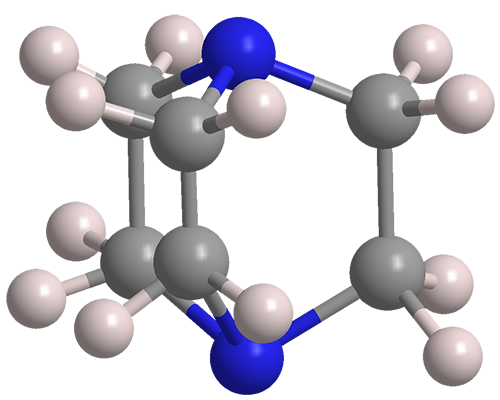What molecule am I?


DABCO, short for1,4-diazabicyclo[2.2.2]octane, is one of a handful of molecules better known by their acronyms than by their full names1. It is also frequently referred to as triethylenediamine, or TEDA.
DABCO has been known for at least 100 years, originally under the name quinolidine. In 1943, Otto Hromatka* and Eva Engel at the University of Vienna synthesized it via the cyclization of the dihydrobromide salt of 1-(2-bromoethyl)piperazine2 or the dihydrochloride salt of 1-(2-chloroethyl)piperazine3. It is commercially produced by the catalytic thermolysis of ethylenediamine or 2-hydroxyethylamine.
Because of its two unhindered tertiary amine groups, DABCO is a strong base (pKa1 of its conjugate acid = 3.0) and nucleophile. It is used as an alkaline catalyst in the production of polyurethane foams. As a Lewis base, it forms crystalline adducts with hydrogen peroxide and sulfur dioxide.
This year, DABCO was featured as the catalyst in two new syntheses. In April, Silong Xu and co-workers at Xi’an Jiaotong University (China) showed that it catalyzes [4 + 2] annulation reactions between 5-methylenehex-2-ynedioates and electron-deficient olefins such as 2-benzylidene-1H-indene-1,3-(2H)-dione to form spirocyclohexadiene adducts in yields up to 90% under mild conditions. Alternative catalysts gave poor yields or no reaction.
In July, Cunde Wang and colleagues at Yangzhou University (China) reported the use of DABCO to promote another set of cyclization reactions. In their process, substituted 2-amino-4H-chromen-4-ones and substituted 2,6-dibenzylidenecyclohexan-1-ones react to form 7,8,9,10-tetrahydro-12H-chromeno[2,3-b]quinolin-12-ones, also under mild conditions and in optimized yields of >80%. As with the Xu process, other basic catalysts gave significantly poorer yields.
1. Another is TEMPO, which will appear as a Molecule of the Week later this year.
2. CAS Reg. No. 89727-93-5.
3. CAS Reg. No. 34782-06-4.
DABCO hazard information*
| Hazard class** | GHS code and hazard statement | |
|---|---|---|
| Flammable solids, category 1 | H228—Flammable solid | |
| Acute toxicity, oral, category 4 | H302—Harmful if swallowed | |
| Skin corrosion/irritation, category 1C | H314—Causes severe skin burns | |
| Serious eye damage/eye irritation, category 1 | H318—Causes serious eye damage | |
| Short-term (acute) aquatic hazard, category 3 | H402—Harmful to aquatic life | |
| Long-term (chronic) aquatic hazard, category 3 | H412—Harmful to aquatic life with long-lasting effects | |
*Compilation of multiple safety data sheets.
**Globally Harmonized System (GHS) of Classification and Labeling of Chemicals. Explanation of pictograms
Molecules from the journals
Sulfur dichloride1 (SCl2) and calcium chloride2 (CaCl2) are chlorine compounds with vastly different properties. SCl2 is a low-boiling (59 °C), toxic, corrosive liquid that releases hydrogen chloride on contact with water. CaCl2 is a high-melting (772 °C), crystalline, hygroscopic solid that dissolves exothermically in water.
What brings these two substances together? Scott E. Lewis and coauthors at the University of South Florida (Tampa) and the University of New Hampshire (Durham) used them as models in a study of first-year chemistry students’ concepts of chemical bonding after they had completed the course. The main takeaway from the study was that students accurately described SCl2 as having covalent bonding; however, “most responses for CaCl2 were covalent or dissonant and thus inappropriately applied.”
The authors discuss the instructional implications of the misapplication of covalent bonding concepts to ionic compounds.
Napelline3 is an alkaloid that Werner Freudenberg* and E. F. Rogers at Fordham University (New York City) isolated in 1937 from Aconitum napellus (monkshood), a highly toxic flowering plant native to the mountains of western and central Europe. The same study also identified a similar new molecule, neoline4.
It was not until 1974 that Karel Wiesner and co-workers at the University of New Brunswick (Fredericton. Canada) published a total synthesis of racemic napelline. This year, Shicheng Jin, Xiangbo Zhao*, and Dawei Ma* at the Chinese Academy of Sciences (Shanghai) reported divergent enantioselective total syntheses of six napelline-type C20-diterpenoid alkaloids, including (–)-napelline itself.
1. CAS Reg. No. 10545-99-0.
2. CAS Reg. No. 10043-52-4.
3. CAS Reg. No. 5008-52-6.
4. CAS Reg. No. 466-26-2.
Molecules from the Journals
MOTW briefly describes noteworthy molecules that appeared in recent ACS journal articles. See this week's
edition below.
DABCO fast facts
| CAS Reg. No. | 280-57-9 |
| SciFinder nomenclature | 1,4-Diazabicyclo [2.2.2]octane |
| Empirical formula | C6H12N2 |
| Molar mass | 112.17 g/mol |
| Appearance | Hygroscopic white crystals |
| Melting point | 158–159 °Ca |
| Boiling Point | 174 °C |
| Water solubility | 450 g/L |
a. Sublimes readily at ambient temperature.

Learn more about this molecule from CAS, the most authoritative and comprehensive source for chemical information.
Molecule of the Week needs your suggestions!
If your favorite molecule is not in our archive, please send us a message. The molecule can be notable for its current or historical importance or for any quirky reason. Thank you!
Stay Ahead of the Chemistry Curve
Learn how ACS can help you stay ahead in the world of chemistry.

